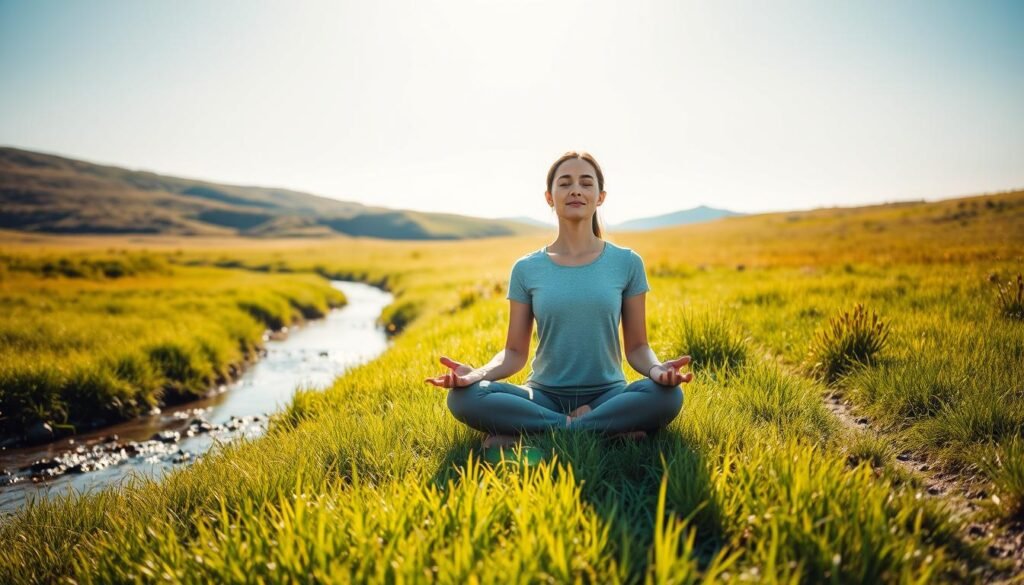Did you know that practicing mindfulness can significantly reduce stress and anxiety? According to the Mayo Clinic Staff, mindfulness exercises can help you direct your attention away from negative thinking and engage with the world around you.
By incorporating simple mindfulness practices into your daily routine, you can experience a range of benefits, from improved emotional regulation to enhanced overall wellbeing. As you explore the world of mindfulness, you’ll discover how these powerful techniques can positively impact your life.
Key Takeaways
- Reduce stress and anxiety with mindfulness practices
- Improve emotional regulation and overall wellbeing
- Enhance your ability to focus and stay present
- Discover simple mindfulness exercises to incorporate into daily life
- Experience the benefits of mindfulness for long-term health
What Is Mindfulness?
At its core, mindfulness is about being present in the moment. It’s a practice that involves paying attention to your thoughts, feelings, and sensations without judgment. This mindful awareness allows individuals to cultivate a deeper understanding of themselves and their experiences.
Definition of Mindfulness
Mindfulness is defined as the practice of being intensely aware of the present moment, encompassing your thoughts, feelings, and bodily sensations. According to the Mayo Clinic Staff, mindfulness is a type of meditation where you focus on being aware of what you’re sensing and feeling without interpretation or judgment. This practice encourages a non-judgmental acceptance of the present moment, fostering a sense of clarity and calm.
Historical Background
The roots of mindfulness can be traced back to ancient Buddhist traditions. The practice was originally known as “sati” in Pali and “smṛti” in Sanskrit, both terms translating to “mindfulness.” It was an integral part of Buddhist meditation practices aimed at developing awareness and understanding of the nature of reality. Over time, mindfulness has evolved and been adapted into various secular practices, making it accessible to people from all walks of life.
Importance in Health & Wellness
Mindfulness has gained significant attention in the health and wellness community due to its numerous benefits. By incorporating mindfulness exercises into daily routines, individuals can experience reduced stress, improved emotional regulation, and enhanced overall wellbeing. The practice of mindfulness encourages a holistic approach to health, addressing both the body and mind. As a result, it has become a valuable tool for those seeking to improve their mental and physical health through mindful practices.
Benefits of Practicing Mindfulness
Mindfulness practices have been shown to enhance mental, physical, and emotional health. By focusing on the present moment, individuals can experience a significant reduction in stress and anxiety, leading to overall wellbeing improvements.
Mental Health Advantages
Practicing mindfulness has been linked to reduced symptoms of anxiety and depression. Studies suggest that mindfulness meditation can decrease the production of stress hormones like cortisol, leading to a calmer mental state. Mindfulness-based stress reduction (MBSR) is a technique that has been particularly effective in this area.
“Mindfulness is the awareness that arises through paying attention on purpose, in the present moment, and non-judgmentally to the current experience.”
Physical Health Improvements
The physical health benefits of mindfulness are equally impressive. Regular mindfulness practice has been shown to lower blood pressure, improve sleep quality, and reduce chronic pain. These benefits are thought to be linked to the reduction in stress and the enhancement of the body’s natural healing processes.
| Physical Health Benefit | Description |
|---|---|
| Lower Blood Pressure | Regular mindfulness practice can help reduce hypertension. |
| Improved Sleep | Mindfulness techniques can enhance sleep quality. |
| Reduced Chronic Pain | Mindfulness meditation can decrease the perception of pain. |
Emotional Wellbeing Benefits
Mindfulness also significantly impacts emotional wellbeing by enhancing emotional regulation and increasing self-awareness. Practitioners often report feeling more grounded and capable of handling life’s challenges. Mindful walking and other mindfulness exercises can be particularly effective in boosting emotional wellbeing.

By incorporating mindfulness into daily life, individuals can experience these benefits firsthand, leading to a more balanced and fulfilling life.
Mindfulness Techniques for Beginners
For individuals new to mindfulness, incorporating simple techniques into daily routines can have profound effects on overall wellbeing. Mindfulness is about being present in the moment, paying attention to your thoughts, feelings, and sensations without judgment.
Breathing Exercises
One of the simplest and most effective mindfulness techniques is breathing exercises. By focusing on your breath, you can calm your mind and reduce stress. To practice:
- Find a quiet and comfortable place to sit or lie down.
- Close your eyes and take slow, deep breaths through your nose and out through your mouth.
- Focus on the sensation of the breath moving in and out of your body.
Tip: Start with short sessions of 5-10 minutes and gradually increase as you become more comfortable with the practice.
Body Scan Meditation
Body scan meditation involves paying attention to different parts of your body, starting from your toes and moving up to the top of your head. This technique helps in releasing physical tension and promoting relaxation.
- Lie down or sit comfortably with your eyes closed.
- Bring your attention to your toes, noticing any sensations, tension, or relaxation.
- Gradually move your attention up through your body, spending a few moments on each area.
Benefit: Regular practice can lead to better awareness of your body’s needs and improved overall physical health.
Mindful Walking
Mindful walking is a great way to cultivate mindfulness while being physically active. It involves paying attention to your walking, the sensation of your feet touching the ground, and the movement of your body.
- Choose a quiet, safe place to walk, free from distractions.
- Pay attention to the sensation of each step, the movement of your legs, and the rhythm of your breath.
- Notice the surroundings, but keep your focus on the act of walking.
Advantage: Mindful walking can be a refreshing way to clear your mind and boost your mood.
Integrating Mindfulness Into Daily Life
Mindfulness is not just a practice, but a way of living that can be integrated into everyday activities. By incorporating mindfulness into daily routines, individuals can enhance their overall wellbeing and quality of life.
Morning Mindfulness Rituals
Starting the day with mindfulness can set a positive tone. Simple practices like deep breathing exercises or a short meditation session can help in achieving a calm and focused state of mind.
- Begin with a 5-minute breathing exercise
- Gradually increase to 10-15 minutes of meditation
- Incorporate gratitude journaling
Mindfulness During Meals
Eating mindfully can transform the experience of having a meal. It involves paying attention to the taste, texture, and smell of the food. Savoring each bite can lead to better digestion and a more enjoyable dining experience.
| Mindful Eating Tips | Benefits |
|---|---|
| Eat slowly | Better digestion |
| Pay attention to flavors | Enhanced enjoyment |
| Avoid distractions | Reduced stress |
Mindful Commuting Practices
Commuting can be a source of stress, but it can also be an opportunity to practice mindfulness. Listening to guided meditations or simply observing the surroundings can make the commute more enjoyable.

By integrating mindfulness into daily activities like commuting, individuals can turn potentially stressful experiences into moments of calm and reflection.
Mindfulness Techniques for Stress Reduction
Effective stress management is achievable through the practice of mindfulness techniques. Mindfulness meditation provides a method for handling stress in a healthier way, reducing blood pressure, and improving sleep quality. By incorporating mindfulness into daily life, individuals can better navigate stressful situations.
Guided Imagery
Guided imagery is a mindfulness technique that involves using visualization to create a peaceful and relaxing atmosphere. This practice can help distract from stressful thoughts and promote relaxation. To practice guided imagery, find a quiet space, close your eyes, and listen to a guided audio recording that leads you through a calming scenario.
Progressive Muscle Relaxation
Progressive muscle relaxation is another effective technique for reducing stress. It involves tensing and relaxing different muscle groups in the body to release physical tension. Start with your toes and work your way up to your head, holding each muscle group for a few seconds before releasing.
Journaling for Mindfulness
Journaling can be a therapeutic outlet for stress and anxiety. By writing down your thoughts and feelings, you can process and release them, gaining clarity and perspective. Set aside a few minutes each day to write in a journal, focusing on the present moment and letting go of worries about the past or future.
| Mindfulness Technique | Description | Benefits |
|---|---|---|
| Guided Imagery | Visualization technique to create a peaceful atmosphere | Reduces stress, promotes relaxation |
| Progressive Muscle Relaxation | Tensing and relaxing muscle groups to release tension | Reduces physical tension, promotes relaxation |
| Journaling for Mindfulness | Writing down thoughts and feelings to process and release them | Reduces stress and anxiety, promotes clarity and perspective |
Mindfulness and Emotional Regulation
Mindfulness plays a crucial role in emotional regulation, helping individuals navigate their feelings more effectively. By practicing mindfulness, one can develop the ability to stay grounded in the present and “de-center” from negative thoughts, thereby enhancing emotional regulation.

Emotional regulation is a complex process that involves understanding and managing one’s emotions. Mindfulness benefits include improved emotional awareness, which is critical for effective emotional regulation.
Understanding Your Emotions
The first step in emotional regulation is to understand your emotions. This involves recognizing and acknowledging your feelings without judgment. Mindfulness meditation can help individuals develop this awareness by encouraging them to observe their emotions as they arise.
Mindfulness meditation teaches individuals to approach their emotions with curiosity and openness, rather than avoidance or suppression. This can lead to a deeper understanding of one’s emotional experiences and improve emotional regulation.
Techniques for Emotional Awareness
Several techniques can enhance emotional awareness, including:
- Journaling: Writing down your feelings and thoughts can help you process and understand your emotions.
- Mindful breathing: Focusing on your breath can calm the mind and reduce emotional reactivity.
- Body scan: Paying attention to physical sensations in the body can help you identify and manage emotional responses.
These techniques, rooted in mindfulness benefits, can be practiced daily to improve emotional awareness and regulation.
Practicing Self-Compassion
Self-compassion is a critical component of emotional regulation. It involves treating oneself with kindness and understanding, especially when experiencing difficult emotions. Practicing self-compassion can help individuals develop a more positive relationship with their emotions.
“The most powerful relationship you will ever have is the relationship with yourself.”
By incorporating mindfulness into daily life, individuals can cultivate self-compassion and improve their emotional regulation. This, in turn, can lead to greater overall well-being and resilience.
Mindfulness in Different Settings
The versatility of mindfulness allows it to be integrated into different aspects of life, including work, home, and school. Mindfulness programs are now commonly found in schools, workplaces, and hospitals, highlighting its broad applicability and effectiveness in enhancing wellbeing across various environments.
Workplace Mindfulness Practices
Mindfulness in the workplace can lead to significant benefits, including reduced stress, improved focus, and enhanced productivity. Simple practices such as taking a few mindful breaths during breaks or practicing mindful walking can make a substantial difference.
- Mindful communication to improve team collaboration
- Stress reduction techniques for a healthier work environment
- Mindfulness exercises to boost creativity and focus
By incorporating mindfulness into daily work routines, employees can experience these benefits firsthand, leading to a more positive and productive work atmosphere.
Mindfulness for Parents
For parents, mindfulness can be a powerful tool in managing the stresses of parenting while fostering a more compassionate and present relationship with their children. Techniques such as mindful parenting classes can help parents stay grounded and responsive.
Key mindfulness practices for parents include:
- Mindful listening to better understand their children
- Practicing self-compassion to manage parenting stress
- Engaging in mindful activities with their children to enhance bonding
Mindfulness in Education
Mindfulness in educational settings has gained significant attention for its potential to improve students’ mental health, focus, and overall academic performance. By integrating mindfulness into the curriculum, schools can provide students with valuable tools for managing stress and achieving success.
Mindfulness programs in schools often include:
- Mindfulness meditation to reduce anxiety and improve concentration
- Mindful movement to enhance physical and mental wellbeing
- Social-emotional learning to foster empathy and self-awareness
By embracing mindfulness, educational institutions can create a supportive and inclusive environment that promotes the wellbeing of both students and staff.
Advanced Mindfulness Techniques
For those looking to deepen their mindfulness practice, advanced techniques can offer a new level of insight and calm. Taking your mindfulness practice to the next level involves exploring advanced techniques such as loving-kindness meditation, mindful yoga, and participating in silence and stillness retreats.
Loving-Kindness Meditation
Loving-kindness meditation, also known as Metta meditation, is a practice that cultivates feelings of love, compassion, and kindness towards oneself and others. This technique involves repeating phrases such as “May I be happy, may I be healthy, may I be at peace” and extending them to others, including those you may have difficulty with.
Benefits of Loving-Kindness Meditation include increased empathy, improved emotional regulation, and enhanced overall wellbeing. Regular practice can lead to a more positive and compassionate outlook on life.
Mindful Yoga Practices
Mindful yoga combines physical postures, breathing techniques, and meditation to promote a state of mindfulness. It encourages awareness of the body and its sensations, helping to cultivate a deeper connection between the body and mind.
| Aspect | Mindful Yoga | Traditional Yoga |
|---|---|---|
| Focus | Mindfulness and awareness | Physical postures and alignment |
| Breathing Techniques | Emphasizes mindful breathing | May or may not focus on breathing |
| Meditation | Often includes meditation practices | May not include meditation |
Silence and Stillness Retreats
Participating in silence and stillness retreats can be a powerful way to deepen your mindfulness practice. These retreats provide an opportunity to disconnect from the distractions of daily life and focus inward.

By incorporating these advanced mindfulness techniques into your practice, you can experience greater calm, clarity, and compassion in your daily life. Whether through loving-kindness meditation, mindful yoga, or silence and stillness retreats, the path to deeper mindfulness is available to those willing to explore it.
Resources for Further Exploration
Deepening your mindfulness practice can be a rewarding journey, and there are numerous resources available to support you. Whether you’re looking for in-depth knowledge or practical tools, you can find a wealth of information to enhance your mindful practices.
Recommended Reading
For those interested in exploring mindfulness through literature, several books offer insightful guidance on mindfulness exercises and mindful practices. Notable authors have written extensively on the subject, providing readers with a range of perspectives and techniques.
Online Learning Opportunities
Online courses and workshops have become increasingly popular, offering flexible and accessible ways to learn about mindfulness. These platforms often feature expert instructors who share their knowledge on various aspects of mindfulness, from foundational principles to advanced techniques.
Mindfulness Tools
Mindfulness apps are another valuable resource, providing users with guided meditations, tracking features, and other tools to support their mindfulness journey. By leveraging these digital tools, individuals can integrate mindful practices into their daily routines more easily.
FAQ
What is mindfulness and how does it improve overall health and wellbeing?
How can I start practicing mindfulness as a beginner?
What are some effective mindfulness techniques for reducing stress?
Can mindfulness be practiced in different settings, such as at work or in school?
What are some advanced mindfulness techniques that I can try?
Where can I find resources to further explore mindfulness and wellness?
How can mindfulness improve my emotional regulation?
Can mindfulness be practiced during daily activities like eating or commuting?
Prabir Dutta
Prabir Dutta is a passionate digital creator, affiliate marketer, and wellness enthusiast who simplifies complex topics like AI tools, Vastu, pet care, and modern living. With a keen eye for SEO, tech trends, and everyday health solutions, he writes to empower readers with actionable, smart-living insights. When not curating content across his network of niche blogs, Prabir enjoys exploring new digital tools that make life easier and more efficient.






